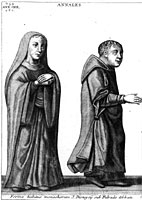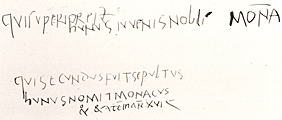- Home
- Men and women
- Hunus the monk (died between 838 and 845)
- Saint Denis (died circa 250)
- Queen Arnegunde (510/520 – 580/590)
- Hunus the monk (died between 838 and 845)
- Abbot Suger (ca 1081 - 1151)
- Pierre, Eudes and Raoul de Montreuil (died in 1267, 1287, and ca. 1318)
- A pilgrim
- A baker
- A traveller: Arnold Van Buchel, 1585
- An artist : Ponce Jacquio (ca. 1515 – 1570)
Benedictine monks' habits from the 11th century, after a representation seen by Mabillon in 1704 on the north door of the basilica's west front.
© BNF
A sarcophagus from the vestibule of the Saint-Barthélemy funerary church was found to contain two superimposed bodies. Two inscriptions were found engraved on the inside walls of the plaster sarcophagus. The first informs us that "the monk buried second was called Hunus and he was in his sixteenth year" (qui secundus fuit sepultus Hunus nomit monacus et etate in an XVI). The second specifies that the "young monk was of noble origin" (qui superior est Hunus iuvenis nobilis monacus). This same Hunus appears in the obituaries and the confraternity lists that, at various points in the life of the monastery, indicate the names of the community's abbots and monks on the days of their deaths. By matching up these accounts, we are able to determine that Hunus died on December 20 between 838 and 845.
Two inscriptions about Hunus the monk, between 838 and 845.
© UASD / M. Wyss
Location of one of the two inscriptions inside the plaster sarcophagus.
© UASD / M. Wyss.
Sarcophagi from the vestibule of the Saint-Barthélemy church. The second one from the bottom holds the body of the monk Hunus.
© UASD / O. Meyer.
The inscription tells us a great deal about the high cultural level that was present at the monastery during the Carolingian era. It informs us that the deceased was born to noble parents. When the child was seven, they entrusted him to the abbey, in return for a donation of money or land, so that he would be educated by monks. Indeed, the reputation of the monastic school had been established since Charles Martel had his son Pepin educated there. But, unlike Pepin, Hunus did not "return to secular iife".




